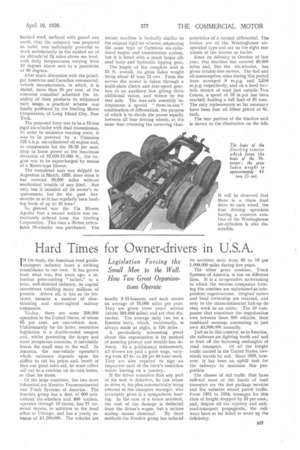Hauling 30-ton Loads in the Andes
Page 40

Page 41

If you've noticed an error in this article please click here to report it so we can fix it.
I N January, 1935, the manageinent of the Cia Minera Aguilar, of northern Argentine, met to consider an unusual problem. For a number of years this old-established mining organization, with its £1,000,000 lead and zinc workings high up amidst the Andes, had been experiencing difficulty in transporting lead and zinc concentrates from the milling plant to the nearest railhead situated at Tres Cruces, 35 miles away. To span that distance by constructing
Two Sterling Multi-wheeled Oilers Solve the Transport Problems of an Argentine Mining Organization 2} Miles Above Sea Level
a narrow-gauge railway would have entailed great expense, considering the quantity of material to be hauled. The alternative was to use road transport.
The next difficulty was the selection of a lorry capable of negotiating the
banked road, surfaced with gravel and earth, that the company was prepared to build, and sufficiently powerful to work satisfactorily in the ratified air at an altitudelof 21 miles above sea level, with daily temperatures varying from 10 degrees above zero -to a ,maximum of 90 degrees.
After much discussion with the principal American and Canadian commercialvehicle manufacturers, in which, it is stated, more than 50 per cent. of the concerns consulted admitted the inability of their products to Withstand such usage, a practical scheme was finally produced by the Sterling Motor Corporation, of Long Island City, New York.
The proposed lorry was to be a 12-ton rigid six-wheeler with dual transmission. In order to minimize running costs, it was to be powered by a Cummins 125 b.h.p. six-cylindered oil engine and, to compensate for the 36-39 per cent. drop in horse power at the maximum elevation of 12,000-13,000 ft., the engine was to be supercharged by means of a Roots-type blower.
The completed unit was shipped to Argentina in March, 1935, since when it has covered 65,000 miles without Mechanical trouble of any kind. Not only has it satisfied all its owner's requirements, but for the past five months or so it has regularly been hauling loads of up to 18 tons!
So pleased was the Cia Miners Aguilar that a second vehicle was immediately ordered from the Sterling Corporation. This time a 30-ton artieulated 10-wheeler was purchased. The
second machine is basically similar to the original rigid six-wheeler, employing the same type of Cummins six-cylindered engine and transmission system, but it is fitted with a much larger allsteel body and hydraulic tipping gear.
The length of the complete unit is 33 ft. overall, its gross laden weight being about 41 tons 15 cwt. From the
• eneine the poWer is taken through a multi-plate clutch and four-speed gearbox to an auxiliary box giving three additional ratios, and thence to the rear axle. The rear-axle assembly incorporates a special " three-in-one " combination of differentials, the purpose of which is to divide the power equally between all four driving wheels, at the same time retaining the cornering char
acteristics of a normal differential. The brakes are of the Westinghouse airoperated type and act on the eight rear wheels of the tractor or trailer.
Since its delivery in October of last year, this machine has covered 40,000 miles and, like the six-wheeler, has given trouble-free service. The fuel and oil-consumption rates during this period have averaged 8 m.p.g. and 2,500 m.p.g. respectively, and on a level twomile stretch of road just outside Tres Critces, a speed of 38 m.p.h has been reached, hauling a full load of 30 tons. The only replacements so far necessary have been four oil filters priced at 6s, each.
The rear portion of the tractive unit is shown in the illustration on the left.




















































































